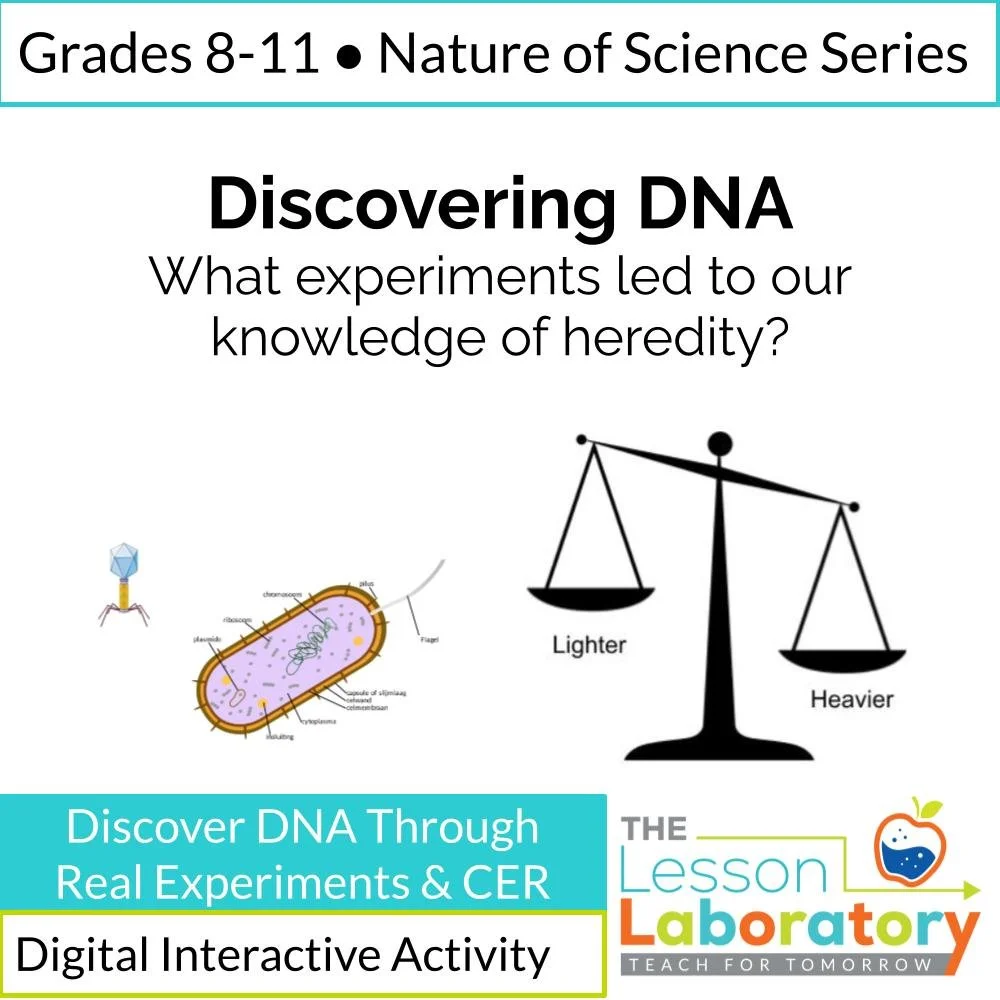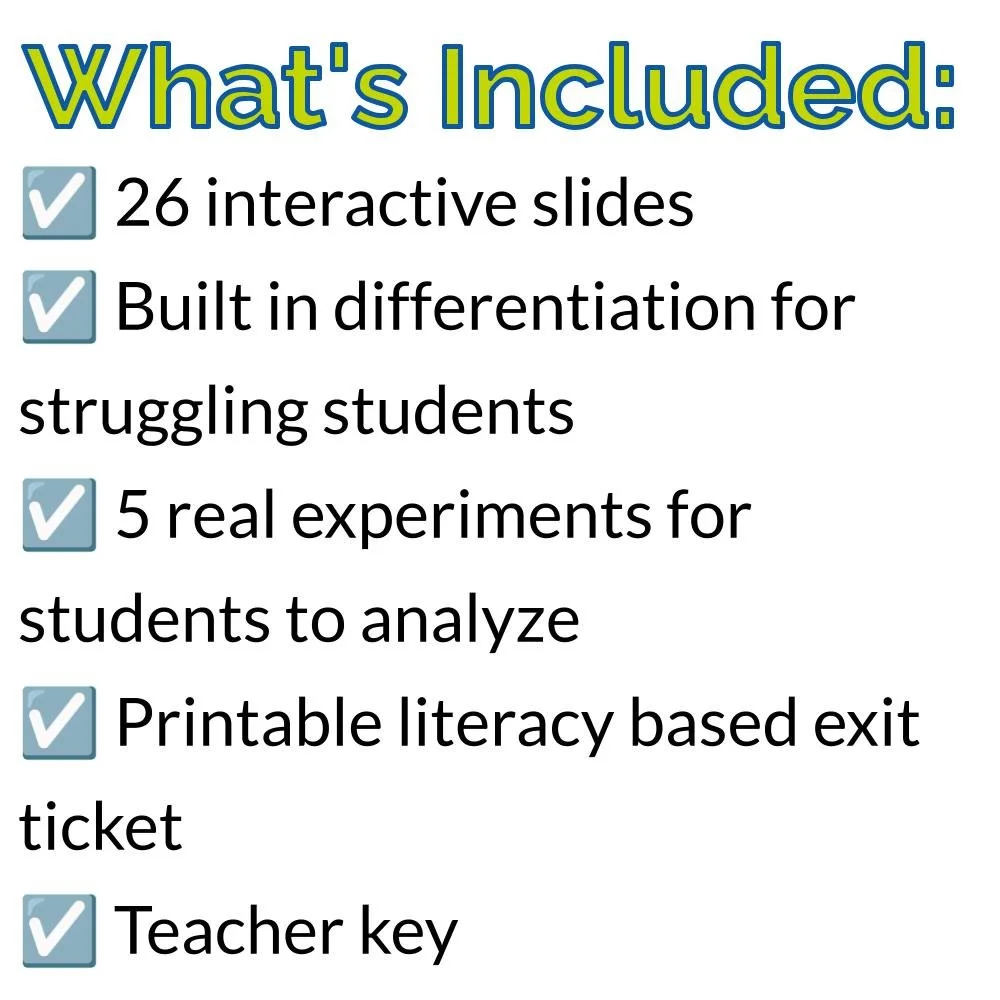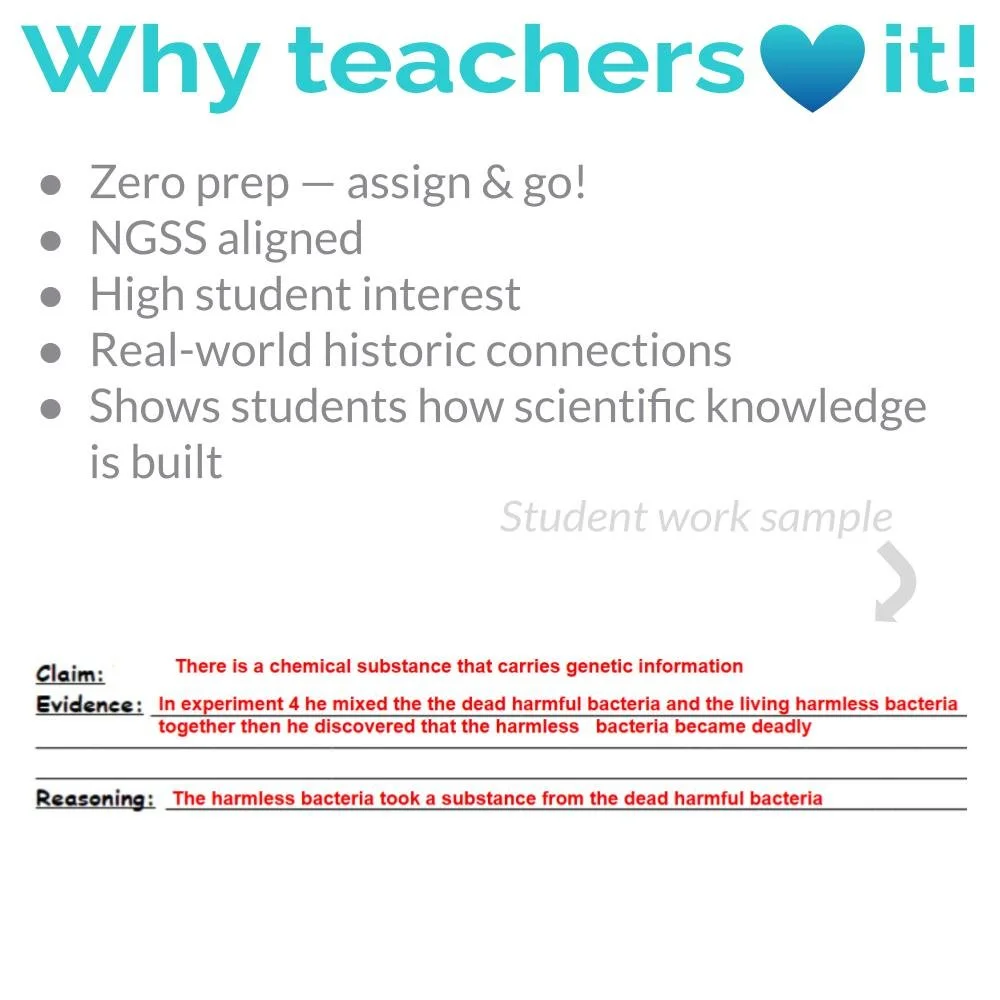



Discovering DNA Digital Lab | Historical Experiments, CER & Modeling Instruction
Students use classic experiments to explain how DNA was identified as the genetic material.
Ignite Curiosity in Heredity: This meticulously crafted, remote learning-ready lesson is your gateway to understanding the remarkable journey that led to the discovery of DNA as the molecule of heredity, along with its intricate structure.
A Journey of Experiments:
Griffith's 1928 Experiment: Step into the shoes of a scientist as you dissect Griffith's groundbreaking experiment. Choose your level of challenge: analyze the data independently, receive a claim hint, or opt for a visual guide to unravel its significance.
Avery, MacLeod, and McCarty's 1944 Experiment: Dive deeper into the world of genetic exploration. Uncover the implications of this transformative experiment through the lens of Claim, Evidence, and Reasoning, tailored to your preferred level of assistance.
Hershey and Chase's 1952 Experiment: Engage with the pivotal experiment that provided crucial insights into DNA. Navigate the complexities of this study, forming your own conclusions supported by robust CER analysis.
Chargaff's 1949 Experiment: Delve into Chargaff's research, a cornerstone in the unraveling of DNA's secrets. Determine its significance with a choice of guidance levels, ensuring a tailored learning experience.
Pioneers of Discovery:
Watson, Crick, Wilkins, and Rosalind Franklin: Gain insight into the contributions of these four luminaries to the understanding of DNA's structure. Reflect on the fairness of accolades, pondering whether recognition was justly distributed.
Empowered Learning: This lesson goes beyond facts, fostering critical thinking and empowering students to unravel the mysteries of DNA through hands-on experimentation and insightful reflection.
Your Journey, Your Pace: Tailor your learning experience to your comfort level, ensuring an enriching and engaging exploration of DNA's fascinating world.
Begin Your DNA Quest: Unearth the captivating journey that led to the discovery of DNA's role in heredity. Embark on this educational odyssey and emerge with a profound understanding of this foundational scientific breakthrough.
Grade & Course Recommendation:
Middle School:Grade 8 honors life science, during heredity or molecule of life units.
High School:Grade 9–11 Biology, as an introduction to molecular genetics.
To preview this lesson, click here.
Cross-Curricular Connections:
History of Science: Connects to the scientific process through the discovery timeline (Griffith, Avery, Hershey–Chase, Watson & Crick).
ELA Integration: Students summarize historical readings and defend evidence-based claims about scientific breakthroughs.
Art Integration: Creation of DNA structure models reinforces spatial understanding.
Daily slide + literacy - based exit ticket included with purchase
Join the Lesson Laboratory and Teach for Tomorrow!
NGSS (Next Generation Science Standards)
HS-LS1-1: Construct an explanation based on evidence for how the structure of DNA determines the structure of proteins, which carry out the essential functions of life through systems of specialized cells. (connection: understanding how DNA’s structure was discovered and why it is central to heredity)
HS-LS3-1: Ask questions to clarify relationships about the role of DNA and chromosomes in coding the instructions for characteristic traits passed from parents to offspring. (connection: exploring historical experiments that established DNA as the molecule of inheritance)
HS-LS3-2: Make and defend a claim based on evidence that inheritable genetic variations may result from new genetic combinations through meiosis, errors during replication, and/or mutations caused by environmental factors. (connection: understanding DNA’s role in heredity and variation)
Science & Engineering Practices: Analyzing and interpreting data; Constructing explanations; Engaging in argument from evidence.
Crosscutting Concepts: Structure and function; Cause and effect; Systems and system models.
Common Core State Standards (ELA – Literacy in Science & Technical Subjects)
High School (Grades 9–12)
CCSS.ELA-LITERACY.RST.9-10.1 / RST.11-12.1: Cite specific textual evidence to support analysis of science and technical texts. (connection: reading passages on Franklin, Watson, and Crick to analyze scientific reasoning and ethics)
CCSS.ELA-LITERACY.RST.9-10.4 / RST.11-12.4: Determine the meaning of key scientific terms and phrases as they are used in context. (connection: interpreting domain-specific vocabulary such as “X-ray crystallography,” “bacteriophage,” or “nucleotide”)
CCSS.ELA-LITERACY.WHST.9-12.1: Write arguments focused on discipline-specific content. (connection: CER writing—claim, evidence, reasoning—based on classic heredity experiments)
CCSS.ELA-LITERACY.WHST.9-12.2: Write informative/explanatory texts, including the narration of scientific experiments and historical context.
Students use classic experiments to explain how DNA was identified as the genetic material.
Ignite Curiosity in Heredity: This meticulously crafted, remote learning-ready lesson is your gateway to understanding the remarkable journey that led to the discovery of DNA as the molecule of heredity, along with its intricate structure.
A Journey of Experiments:
Griffith's 1928 Experiment: Step into the shoes of a scientist as you dissect Griffith's groundbreaking experiment. Choose your level of challenge: analyze the data independently, receive a claim hint, or opt for a visual guide to unravel its significance.
Avery, MacLeod, and McCarty's 1944 Experiment: Dive deeper into the world of genetic exploration. Uncover the implications of this transformative experiment through the lens of Claim, Evidence, and Reasoning, tailored to your preferred level of assistance.
Hershey and Chase's 1952 Experiment: Engage with the pivotal experiment that provided crucial insights into DNA. Navigate the complexities of this study, forming your own conclusions supported by robust CER analysis.
Chargaff's 1949 Experiment: Delve into Chargaff's research, a cornerstone in the unraveling of DNA's secrets. Determine its significance with a choice of guidance levels, ensuring a tailored learning experience.
Pioneers of Discovery:
Watson, Crick, Wilkins, and Rosalind Franklin: Gain insight into the contributions of these four luminaries to the understanding of DNA's structure. Reflect on the fairness of accolades, pondering whether recognition was justly distributed.
Empowered Learning: This lesson goes beyond facts, fostering critical thinking and empowering students to unravel the mysteries of DNA through hands-on experimentation and insightful reflection.
Your Journey, Your Pace: Tailor your learning experience to your comfort level, ensuring an enriching and engaging exploration of DNA's fascinating world.
Begin Your DNA Quest: Unearth the captivating journey that led to the discovery of DNA's role in heredity. Embark on this educational odyssey and emerge with a profound understanding of this foundational scientific breakthrough.
Grade & Course Recommendation:
Middle School:Grade 8 honors life science, during heredity or molecule of life units.
High School:Grade 9–11 Biology, as an introduction to molecular genetics.
To preview this lesson, click here.
Cross-Curricular Connections:
History of Science: Connects to the scientific process through the discovery timeline (Griffith, Avery, Hershey–Chase, Watson & Crick).
ELA Integration: Students summarize historical readings and defend evidence-based claims about scientific breakthroughs.
Art Integration: Creation of DNA structure models reinforces spatial understanding.
Daily slide + literacy - based exit ticket included with purchase
Join the Lesson Laboratory and Teach for Tomorrow!
NGSS (Next Generation Science Standards)
HS-LS1-1: Construct an explanation based on evidence for how the structure of DNA determines the structure of proteins, which carry out the essential functions of life through systems of specialized cells. (connection: understanding how DNA’s structure was discovered and why it is central to heredity)
HS-LS3-1: Ask questions to clarify relationships about the role of DNA and chromosomes in coding the instructions for characteristic traits passed from parents to offspring. (connection: exploring historical experiments that established DNA as the molecule of inheritance)
HS-LS3-2: Make and defend a claim based on evidence that inheritable genetic variations may result from new genetic combinations through meiosis, errors during replication, and/or mutations caused by environmental factors. (connection: understanding DNA’s role in heredity and variation)
Science & Engineering Practices: Analyzing and interpreting data; Constructing explanations; Engaging in argument from evidence.
Crosscutting Concepts: Structure and function; Cause and effect; Systems and system models.
Common Core State Standards (ELA – Literacy in Science & Technical Subjects)
High School (Grades 9–12)
CCSS.ELA-LITERACY.RST.9-10.1 / RST.11-12.1: Cite specific textual evidence to support analysis of science and technical texts. (connection: reading passages on Franklin, Watson, and Crick to analyze scientific reasoning and ethics)
CCSS.ELA-LITERACY.RST.9-10.4 / RST.11-12.4: Determine the meaning of key scientific terms and phrases as they are used in context. (connection: interpreting domain-specific vocabulary such as “X-ray crystallography,” “bacteriophage,” or “nucleotide”)
CCSS.ELA-LITERACY.WHST.9-12.1: Write arguments focused on discipline-specific content. (connection: CER writing—claim, evidence, reasoning—based on classic heredity experiments)
CCSS.ELA-LITERACY.WHST.9-12.2: Write informative/explanatory texts, including the narration of scientific experiments and historical context.